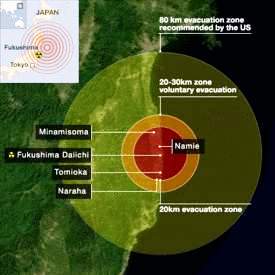|
Fukushima Evacuations Too Late ..
by staff report via sal - Japan Times Tuesday, Dec 13 2011, 9:45pm
international /
health related /
other press
High exposure to radiation possible before officials acted
FUKUSHIMA — Some residents near the Fukushima No. 1 plant might have been exposed to up to 19 millisieverts of radiation during the first four months of the nuclear crisis, the Fukushima Prefectural Government said Tuesday.

This indicates residents subject to the greatest exposure may have been outside the immediate evacuation area, in locations where radioactive hot spots were later revealed and prompted belated evacuation advisories long after the crisis started March 11.
The radiation estimates are based on atmospheric and other external readings and forecasts and do not include food, water and other means of exposure.
The prefecture released its estimates of radiation for residents in 12 municipalities near the plant — Namie, Kawamata, Iitate, Futaba, Okuma, Minamisoma, Tamura, Tomioka, Naraha, Hirono, Katsurao and Kawauchi. The plant occupies parts of Futaba and Okuma.
It said residents who evacuated from high-risk areas in the village of Iitate in late June might have been exposed to the biggest amount — 19 millisieverts.
The prefecture has distributed questionnaires to all of its roughly 2 million residents but had received responses from only about 18 percent of residents as of the end of November.
The prefecture said it based its estimated dosages of radiation from the plant on the timing and places of evacuation. Some residents who haven't returned the questionnaires said they don't remember how long they stayed in certain locations after the quake, resulting in the low survey response rate, officials said.
According to the estimate, residents in the 20-km no-go zone around the plant who evacuated in the early stages of the crisis were exposed to 0.8 to 2.3 millisieverts during the period.
Those in radioactive hot spots outside the no-go zone, where the government did not promptly urge residents to evacuate, may have been exposed to 0.84 to 19 millisieverts.
The prefecture is trying to learn how many people were in the hot spots and for how long. Thousands of residents left the prefecture altogether.
The average dosage is estimated at just more than 1 millisievert, the maximum limit of radiation exposure per year in normal times. The dosages don't include exposure to natural radiation.
Fukushima Medical University Vice President Shunichi Yamashita, who headed the team conducting the survey, said the estimated readings are much lower than those after the 1986 Chernobyl accident and should not pose a problem.
By announcing the estimates, the prefecture hopes more residents will respond to the survey, which would result in a better understanding of the exposure numbers.
© 2011 Japan Times
http://www.japantimes.co.jp/text/nn20111213x1.html
<< back to stories
|